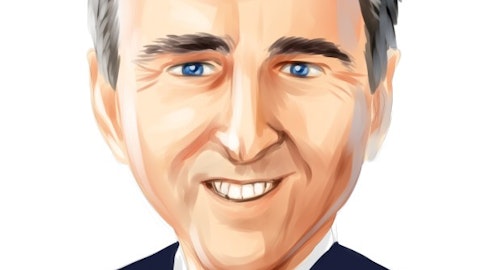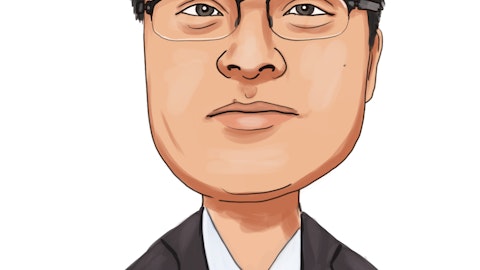Manuel Navas: No. That’s really helpful. Now equipment finance alone, what kind of expectations as a percentage of loans by the end of this year kind of where can that portfolio grow to in the next two years and then kind of what are the yields that you are getting currently?
Mike Price: Yeah. Jane, why don’t we let you take that one?
Jane Grebenc: Let’s start with, Jim, where he would start with yields, Mike, and then I will back clean up.
Jim Reske: Yeah. So the yields in that business are really strong, really nice. But right now growing over 7% and that’s really where we like it to be. We didn’t build that business to be double-digit yields. We don’t want to take on that kind of risk. The equipment is mostly things like trucks and nice bread and butter kind of equipment like that and the yields are really very additive to our overall NIM and to the bank as a whole. In terms of like I think your question was like a proportion of our loan growth next year, it’s probably 30% to 40% of the loan growth next year. We are going to all draw a big picture number of what we expect to be booking this year. We couldn’t finance, it’s really additive. So that’s what we can say. The other businesses are growing at historical moderate growth rates are growing and the equipment finance stayed on top, so they can build — put the whole picture together and build the whole picture. Jane, if you want to add to that?
Jane Grebenc: Sure. We are continuing to add salespeople. And as Jim said, it’s a big portion of our loan growth this year. And I thought I asked — I heard you ask ultimately whether we see it bank and it’s probably never going to be more than 10% to 15% of the loan portfolio.
Manuel Navas: That’s perfect. That’s helpful. How many people have you added? How much is the footprint on your employee base in this division?
Jane Grebenc: It’s small. The leader of the group, Rob Boyer, has been very, very careful. We add out a few employees at a time, because we have been very careful about collection and onboarding. And we have been adding primarily salespeople and we, probably, have a couple of dozen people in the group right now.
Manuel Navas: Okay. That’s really helpful. Thank you, guys.
Mike Price: Thank you.
Operator: Our next question comes from Daniel Cardenas with Janney Montgomery Scott.
Daniel Cardenas: Good afternoon, guys. How are you?
Mike Price: Good.
Daniel Cardenas: Just a quick follow-up on the equipment finance, what’s the duration of that portfolio and the average loan size?
Mike Price: Average loan size is about $160,000. It was up a little bit from our earliest projection just because of the way the market was moving, it might come down a little bit from that. Duration was, I think, 60 months to 70 months or Jane you could correct me on that. One — but one of the features of that business is unlike the auto business, it really prepays. So the duration is very kind of similar to the stated life.
Jane Grebenc: Yeah. Just about five years.
Daniel Cardenas: Okay. So then to get to the growth that you are projecting right now, is it safe to assume that you will kind of stay within that average or do you kind of foresee going up in size to help you get there?
Jane Grebenc: We don’t have any immediate plans to increase the size. We like the space because we like the yields a lot and we like the collateral. So we will probably stay about where we are, at least for the foreseeable future.
Daniel Cardenas: Okay. And what kind of loss rate are you building into your model for the equipment finance?
Jane Grebenc: Jim, do you want me to take that?
Jim Reske: Yeah. If you have it at your fingertips, please.
Jane Grebenc: I do. We assumed initially 75 basis points. As you can imagine, it’s next to nothing. So far the actual losses have been zero.
Daniel Cardenas: All right. Congrats on that. And then maybe just jumping over to borrowings, in this quarter we saw a pretty substantial jump. Can you maybe give us some color as to how we should think about borrowings on a go-forward basis?
Mike Price: Well, like we have been saying, our long-term goal is that we want to make sure that we fund our loan growth and deposit growth. But when in any given quarter, we don’t have that, we are able to tap into borrowings, so we have a very large amount of liquidity. So funding our loan book is not a problem. In the fourth quarter, we just had that dynamic there. We didn’t want to have an influx of deposits, because of the inflexibility of deposits, assets are so flexible. So if we had gotten to the end of December of last year and we are trying to avoid the $10 billion mark, you can sell a loan portfolio very quickly and pay down overnight borrowings, the same day very quickly. You can’t do that if it was funded with deposits, because you can’t stuff money in envelopes and then it back to depositors and give them their money back.
So that gave us this balance sheet flexibility we really like going into the end of last year. Now like I said, there’s plenty of money available. The money that we are raising in the market even with CD specials and other kinds of specials is all below our incremental cost of over net borrowings. So that’s all better for us in the borrowings and the money is really flowing in in response to those specials. So that’s kind of how we manage and how we look at it.
Daniel Cardenas: Okay. Good. And then last question for me in terms of — as I look at your deposits, do you guys have any brokered deposits in portfolio right now?
Mike Price: No.





